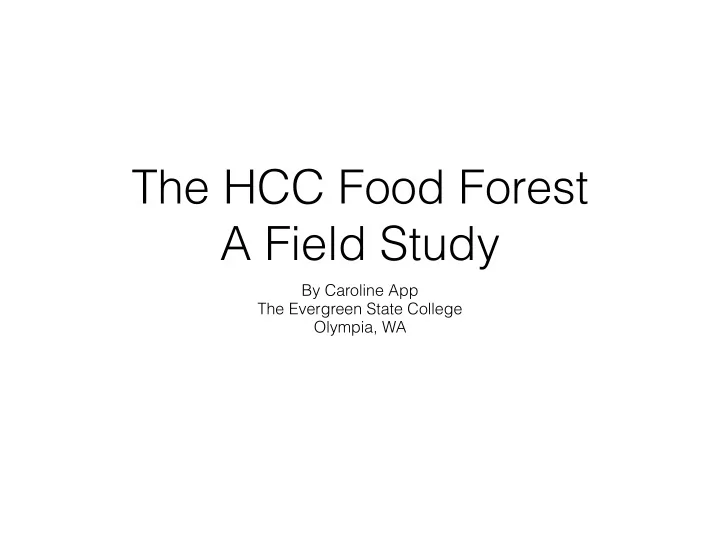

The HCC Food Forest A Field Study By Caroline App The Evergreen State College Olympia, WA
The Start… • Natalie Pyrooz first implemented the HCC food forest garden as her thesis for her MES. The garden was implemented in 2009. • The food forest was her experiment as to whether an on campus food forest could facilitate sustainable learning and living at the institutional and student scale.
The Conclusion • Ms. Pyrooz conducted surveys at the end of her program she began the project with. • In the surveys, students reported they felt more engaged food systems and sustainability through helping implement the project.
My Start • I began the project with an idea of working with local land. • I was introduced to the site with the intention of expanding it with more native edibles. • While the ethnobotany interested me, I was just as interested in ways the forest developed through its time there.
Learning Objectives • My goal was to expand the bcc food forest while exploring the topic of how pollinators benefit from native plants. • Along with the above, I also observed the site conditions and wanted to learn about the species there and soil.
Research and Blog • I researched native plants and wildflowers to add diversity to the site and benefit pollinators. • I observed flourishing thickets of salmonberry, nootka rose, and red flowering currant. • While I picked wildflowers for the garden bed, I chose taller shrubs to compliment space near the back for the different “stages” or “niches”.
Research and Blog • I posted blog posts in relation to the site and uploaded my completed base map with measurements. • I looked into the soil needs of several areas around the site and completed blogs on different soil differences and my plant list based on those observations.
Successes and Setbacks • My favorite resource of learning was a book by Russell Link called “Landscaping for Wildlife in the Pacific Northwest. • Through the book, I learned about the food forest as a design of polyculture, working in layers to provide different ecological functions.
Successes and Setbacks • With the planning of the garden also came some challenges. • I received a grant through the Clean Energy Committee, and learned setbacks happen in receiving letter awards. Because of this, my project “planting” will not be complete week 10.
Successes and Setbacks • My hopes were to have the plants installed week 6, observe them, and write blog posts based on their progress. • Despite this, I will be waiting for the budget number so that I may finish my “planting” portion in the coming days. • I also learned there may or may not be a difference between “budget number” and “grant award”.
Outcomes • While I may not have the “planting” finished, I created videos to demonstrate my learning through my project. • My Wk 7 video was an introduction to site while my Wk 10 video is a journey through initiative, patience, and moving forward.
Outcomes • My blog posts cover a variety of subjects brought forth from my learning objectives. • My blogs are mostly an exploration as to how a polyculture design with native species benefit pollinators. • They do benefit.
Outcomes • Native pollinators like the mason bee benefit from native plants by collecting more pollen from them. • Likewise, native plants benefit from native pollinators to be able to reproduce and maintain diversity. • Conversely, there is also evidence to suggest non- native pollinators are competitive for resources.
Outcomes • My instagram feed was meant to be interactive as to the species of bees and insects present and show my progress on fixing the site up. • All of the pictures featured on my blog are original photos from the site (or used textbooks).
Acknowledgments • I would like to thank RAD Sustainability for having me intern in this space. • I would like to thank Joe Anderson and Joe Clevenger for being knowledgable and supportive supervisors. • I would like to thank Steve Scheuerell and Sarah Williams for continuous support and the field study opportunity.
Recommend
More recommend